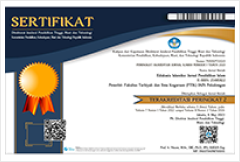Salafi-Jihadist Movements and Ideology in Educational Institutions: Exploring the Nexus with Religious Moderation
DOI:
https://doi.org/10.28918/jei.v8i1.365Keywords:
Salafi Jihadis, Moderasi Beragama, Lembaga PendidikanAbstract
The increasing global actions of “jihad” significantly impact the landscape of Islam in Indonesia. Within this context, educational institutions have not been immune to the infiltration of Salafi Jihadist ideologies and movements. This study examines the ideology, characteristics, and interpretation of Salafi Jihadist Islam within educational institutions and its relationship with the mainstreaming of religious moderation. The historical approach is employed in this study. A qualitative research design is employed to investigate these phenomena, combining content analysis from a comprehensive literature review and actor analysis. This methodology enables a thorough examination of Salafi Jihadist religious ideology and responses to the infiltration of Salafi Jihadist ideology through religious moderation. The findings of this study reveal several key insights: a) the ideology and movements of Salafi Jihadists in educational institutions pose a significant threat to religious practices and beliefs; b) the Salafi Jihadist ideology, with its distinctive Salafi Islamic characteristics, exerts a strong influence that attracts followers; and c) mainstreaming religious moderation in educational institutions through various means such as curriculum development, fostering a moderate culture, implementing policies, and promoting good practices can serve as a preventive measure against the infiltration of Salafi Jihadist ideology and movements. These research findings have important implications for developing more effective strategies and interventions to counter the Salafi-Jihadi movements and promote education that is grounded in moderate and inclusive Islamic values.
References
Admin. (2018). Survei PPIM: 57 Persen Guru Berpandangan Intoleran. Convey Indonesia. https://conveyindonesia.com/survei-ppim-57-persen-guru-berpandangan-intoleran-2/
Admin. (2022). Partisipasi Aktif Masyarakat Mendorong Penurunan Indeks Resiko dan Indeks Potensi Radikalisme dan Terorisme Tahun 2022. BNPT. https://www.bnpt.go.id/partisipasi-aktif-masyarakat-mendorong-penurunan-indeks-resiko-dan-indeks-potensi-radikalisme-dan-terorisme-tahun-2022
Al-Thalibi, A. A. (2006). Dakwah Salafiyah Dakwah Bijak, Meluruskan Sikap Keras Dai Salafi. Hujjah Press.
Ali, M. (2019). Understanding Salafis, Salafism and Modern Salafism. Al-Islāmiyyāt, 41(1), 125–136. https://doi.org/https://doi.org/10.17576/islamiyyat-2019-4001-15
Azra, A. (2022). Memberantas Fobia-Islam; Proklamasi Majelis Umum Pbb 15 Hari Internasional. Paper untuk Webinar ‘Membincang Resolusi PBB tentang Penghapusan Islamophobia. Dialektika, Tajdid Institute.
Babbie, E. (2008). The Basic of Sosial Research. Thomson Higher Education.
Bazian, H., & Awaad, R. (2021). Islamophobia, Muslim Safety, and Violence Survey.
Damarjati, D. (2018). Survei: Potensi Intoleransi Muslim RI Meningkat, Projihad Keras 13%. DetikNews. https://news.detik.com/berita/d-3839963/survei-potensi-intoleransi-muslim-ri-meningkat-projihad-keras-13
Diko, E. (2023). Setara Institute: Jumlah Pelajar yang Intoleran Aktif Meningkat, 83 Persen Nilai Pancasila Bisa Diganti. Sura Kalbar. https://www.suarakalbar.co.id/2023/05/setara-institute-jumlah-pelajar-yang-intoleran-aktif-meningkat-83-persen-nilai-pancasila-bisa-diganti/
Esposito., J. L. (2002). Unholy War : Teror Atas Nama Islam. Ikon Teralitera.
Faiq, H. (2018). Survei LSI: Pro-Pancasila Turun 10%, Pro-NKRI Bersyariah Naik 9%. DetikNews. https://news.detik.com/berita/d-4119173/survei-lsi-pro-pancasila-turun-10-pro-nkri-bersyariah-naik-9
Hadi Kuntjara, H., Rasyid, I., & Dkk. (2019). Kajian Kontra Radikalisme dan Kebijakan. chrome-extension://efaidnbmnnnibpcajpcglclefindmkaj/https://habibiecenter.or.id/img/publication/5c510fdc39962c13c7ddaa102a1f0109.pdf
Hegghammer, T. (2009). Global Salafism: Islam’s New Religious Movement. Columbia University Press.
Humas. (2022). BRIN dan BNPT Dukung Penanggulangan Terorisme Berbasis Riset Teknologi. Brin. https://brin.go.id/news/99301/brin-dan-bnpt-dukung-penanggulangan-terorisme-berbasis-riset-teknologi
Jones, S. G. (2014). APPENDIX List of Salafi-Jihadist Groups. In A Persistent Threat. RAND Corporation. https://www.jstor.org/stable/10.7249/j.ctt7zvzgm.11
Krismono, K. (2017). Salafisme di Indonesia : Ideologi, Politik Negara, dan Fragmentasi. Millah, 16(2), 173–202. https://doi.org/10.20885/millah.vol16.iss2.art2
Ma’ruf, A. (2016). Global Salafism Sebagai Gerakan Revivalisme Islam. Al-Murabbi, 1(2), 243–272. https://jurnal.yudharta.ac.id/v2/index.php/pai/article/view/397
Mandailing, M. (2016). Kalangan muda rentan penyebaran paham radikal terorisme. Antara News.
Manshur, F. M., & Husni, H. (2020). Promoting Religious Moderation through Literary-based Learning: A Quasi-Experimental Study. International Journal of Advanced Science and Technology, 29(6). http://sersc.org/journals/index.php/IJAST/article/view/19864
Mayfield, E. N. (2015). Characteristics of Salafi Jihadist Activists. https://ideaexchange.uakron.edu/honors_research_projects/156/
Muthohirin, N., Kamaludin, M., & Mukhlis, F. (2022). Salafi Madrasas: Ideology, Transformation, and Implication for Multiculturalism in Indonesia. FIKRAH, 10(1), 81–11. https://doi.org/10.21043/fikrah.v10i1.14380
Naj’ma, D. B. A., & Bakri, S. (2021). Pendidikan Moderasi Beragama Dalam Penguatan Wawasan Kebangsaan. Academica, 5(2), 422–434. https://ejournal.uinsaid.ac.id/index.php/academica/article/view/4919
Newswire. (2018). Daftar 7 Kampus Top di Indonesia Terpapar Radikalisme. Kabar 24. https://kabar24.bisnis.com/read/20180531/255/801534/daftar-7-kampus-top-di-indonesia-terpapar-radikalisme
Panrb. (2022). BNPT: Indeks Resiko Terorisme dan Potensi Radikalisme di 2022 Turun. Kementerian Pendayagunaan Aparatur Negara Dan Reformasi Birokrasi.
Peace, I. for E. &. (2020). Institute for Economic & Peace, Global Terrorism Index 2020; Measuring the impact of terrorism. https://reliefweb.int/sites/reliefweb.int/files/resources/GTI-2020-web-2.pdf, diakses pada 4 April 2022
Prihandono, W. (2013). Upaya Transnasionalisasi Pergerakan Al Qaeda Pasca-11 September 2001. Global & Policy, 1(1). http://ejournal.upnjatim.ac.id/index.php/jgp/article/view/2010
Ranstorp, M. (2020). Introduction. In Contextualising Salafism and Salafism Jihadism (p. 8). Nationalt Center for Forebyggelse af Ekstremisme. chrome-extension://efaidnbmnnnibpcajpcglclefindmkaj/https://www.stopekstremisme.dk/en/research-and-analysis/contextualising-salafism-and-salafi-jihadism.pdf
Sadidah, H. (2023). BNPT: Indeks Potensi Radikalisme 2022 Menurun. Kbr.Id. https://kbr.id/nasional/02-2023/bnpt-indeks-potensi-radikalisme-2022-menurun/110962.html
Said, E. (1997). Covering Islam: How the Media and the Experts Determine How We See the Rest of the World (L. Walther (ed.)). Vintage Books. https://www.goodreads.com/book/show/151579.Covering_Islam
Saifudin, L. H. (2019). Moderasi Beragama. Badan Litbang dan Diklat Kementerian Agama RI.
Samari, G. (2016). Islamophobia and Public Health in the United States. Am J Public Health, 106(11), 1920–1925. https://doi.org/10.2105/AJPH.2016.303374
Sanaky, H. A., & Safitri, E. (2016). Radikalisme Agama Dalam Perspektif Pendidikan. Millah, 14(2). https://doi.org/10.20885/millah.volxiv.iss2.art7
Saputra, E. Y. (2023). 78 Tahun Pancasila, SETARA Institute Catat Intoleransi Remaja SMA Meningkat. Tempo.Co. https://nasional.tempo.co/read/1732508/78-tahun-pancasila-setara-institute-catat-intoleransi-remaja-sma-meningkat
Setara. (2019). Tipologi Keberagamaan Mahasiswa: Survei Di 10 Perguruan Tinggi Negeri.
Shihab, M. Q. (2005). Tafsir Al-Mishbah (9th ed.). Lentera Hati.
Silke, A. (2008). A Review of the Impact of 9/11 and the Global War on Terrorism. In C. Hsinchun, R. Edna, S. Joshua, A. Silke, & G. Boaz (Eds.), Terrorism Informatics Knowledge Management and Data Mining for Homeland Security (18th ed., pp. 27–50). Springer,Boston, M.A. https://doi.org/https://doi.org/10.1007/978-0-387-71613-8_2
Sitepu, M. (2017). Satu dari empat pelajar Indonesia “siap berjihad”: Bagaimana sekolah menangkal radikalisme? BBC Indonesia. https://www.bbc.com/indonesia/indonesia-41820400
Suralaga, F., Zulkifli, Mubarak, M. Z., & Kharlie, A. T. (2020). Fighting Against Violent Extremist Ideology at Indonesian Universities : Strategies and Effectiveness. International Journal of Advance Science and Technology.
W. Roberts, B. (2009). The Macroeconomic Impacts of The 9/11 Attack: Evidence from Real-Time Forecasting. https://www.britannica.com/event/September-11-attacks, diakses pada 3 April 2022
Wahid, A. (2009). Ilusi Negara Islam: Ekspansi Gerakan Islam Transnasional di Indonesia. The Wahid Institute.
Wendry, N., Sefriyono, S., & Yusuf, M. (2020). The Map of Jihad Meaning Among Junior High School Students in Padang. ESENSIA: Jurnal Ilmu-Ilmu Ushuluddin, 21(2). https://doi.org/https://doi.org/10.14421/esensia.v21i2.2316
Wibisono, S., Louis, W. R., & Jetten, J. (2019). A Multidimensional Analysis of Religious Extremism. Frontiers in Psychology, 10. https://doi.org/10.3389/fpsyg.2019.02560
Zunita Amalia, P. (2018). Survei Alvara Ungkap Peta Pandangan Keagamaan di Kalangan Profesional. DetikNews. https://news.detik.com/berita/d-3696118/survei-alvara-ungkap-peta-pandangan-keagamaan-di-kalangan-profesional






















